Thomson 545, 570 User Manual

SpeedTouch™
545/570
Multi-User ADSL Gateways
Setup and User’s Guide
Release R4.2.1
500 SERIES

SpeedTouch™
545/570
Setup and User’s Guide
Release R4.2.1

Status v1.0
Change Note PeckelbeenS
Short Title Setup and User's Guide ST545/570 R4.2.1 (en)
Copyright © 2003 THOMSON. All rights reserved. Passing on, and copying of this document, use and communication of its contents is not permitted without written authorization from THOMSON. The content of this document is furnished for informational use only, may be subject to change without notice, and should not be construed as a commitment by THOMSON. THOMSON assumes no responsibility or liability for any errors or inaccuracies that may appear in this document.

Contents
1 |
SpeedTouch™ Installation ............................................ |
5 |
1.1 |
Getting Acquainted with the SpeedTouch™.................................................... |
6 |
1.2 |
Setting Up the SpeedTouch™............................................................................ |
9 |
1.3 |
SpeedTouch™ Configuration Setup ................................................................ |
11 |
1.3.1 |
Microsoft Windows SpeedTouch™ Configuration Setup .................................................... |
12 |
1.3.2 |
Operating System Independent SpeedTouch™ Configuration Setup................................ |
19 |
2 |
SpeedTouch™ Internet Connectivity ........................ |
23 |
2.1 |
Internet Connections via SpeedTouch™’s Embedded PPP Dial-in Client. |
. 24 |
2.1.1 |
Using the MS Windows XP Internet Gateway Device Control Client ............................. |
25 |
2.1.2 |
Using the SpeedTouch™ Web Pages ........................................................................................ |
27 |
2.2 |
Connect to the Internet via a Host PPPoE Dial-in Client ............................. |
29 |
2.2.1 |
Using an MS Windows XP BroadBand Connection............................................................... |
30 |
2.2.2 |
Using the Mac OS X PPPoE Dial-in Client ............................................................................... |
34 |
3 Dr SpeedTouch™ ......................................................... |
37 |
4 |
Wireless Connectivity.................................................. |
41 |
4.1 |
First-time Wireless Client Association............................................................ |
43 |
4.2 |
Connecting Wireless Clients ............................................................................ |
45 |
E-DOC-CTC-20030814-0001 v1.0 |
3 |
|

5 |
SpeedTouch™ Web Interface..................................... |
47 |
5.1 |
Basic Topics Menu Links ................................................................................... |
50 |
5.2 |
Advanced Topics Menu Links ........................................................................... |
56 |
6 SpeedTouch™ NAPT Manager .................................. |
67 |
7 |
Support.......................................................................... |
73 |
7.1 |
Upgrading a SpeedTouch™545 for Wireless Networking ............................ |
74 |
7.2 |
Using the Wall Mounting Assembly................................................................. |
76 |
7.3 |
SpeedTouch™ System Software Upgrade...................................................... |
77 |
7.3.1 |
Checking for new System Software via the SpeedTouch™ CD Browser........................ |
78 |
7.3.2 |
Checking for System Software via the SpeedTouch™ Web Pages (all OSs) ................... |
80 |
7.3.3 |
Upgrade via the SpeedTouch™ Upgrade Wizard .................................................................. |
81 |
7.3.4 |
Upgrade via the SpeedTouch™ Web Pages ............................................................................ |
86 |
7.4 |
SpeedTouch™ Default Configuration.............................................................. |
88 |
7.5 |
UPnP™ on Windows XP Systems ................................................................... |
89 |
7.6 |
Troubleshooting................................................................................................. |
91 |
4 |
E-DOC-CTC-20030814-0001 v1.0 |
|

|
1 SpeedTouch™ Installation |
|
|
1 |
SpeedTouch™ Installation |
Introduction |
|
Thank you for purchasing a SpeedTouch™ Multi-User ADSL Gateway! |
|
|
With the SpeedTouch™545 Wireless Upgradeable and SpeedTouch™570 Wireless |
|
Multi-User ADSL Gateways two cutting-edge technologies are combined: ADSL and |
|
Wireless LAN (WLAN). |
|
With this answer to the increasing popularity of both technologies, users can build a |
|
home or small office (Wireless) LAN without any need for network wiring and surf the |
|
Internet at high speed; all combined in one device. |
|
The SpeedTouch™545 Wireless Upgradable Multi-User ADSL Gateway allows you to |
|
add wireless connectivity at a later stage by installing a wireless upgrade card. With the |
|
SpeedTouch™010 wireless upgrade card installed, the SpeedTouch™545 becomes a |
|
Wi-Fi™ certified Wireless Multi-User ADSL Gateway. |
Contents |
|
This Setup and User’s Guide will assist you in getting acquainted with the Speed- |
|
|
Touch™545/570 Wireless Multi-User ADSL Gateways and in getting connected quickly |
|
to the Internet. |
Terminology |
|
Generally, the SpeedTouch™545(i) and SpeedTouch™570(i) will be referred to as |
|
|
SpeedTouch™ in this Setup and User’s Guide unless specifically indicated. |
Safety instructions |
|
Before connecting the SpeedTouch™, please read the SpeedTouch™ Quick Installation |
|
|
Guide and Safety Instructions. |
UPnP™ |
|
The SpeedTouch™ is a UPnP™ certified product. This feature enables your computer |
|
|
to discover and control UPnP™ devices on the network. |
|
If you are running Microsoft Windows XP, it is strongly recommended to add the |
|
UPnP™ software component to your system. |
|
For more information see MS Windows XP Help and “7.5 UPnP™ on Windows XP |
|
Systems” on page 89. |
Documentation and |
|
The SpeedTouch™ products continue to evolve as extra and new functionalities are |
|
software updates |
made available. |
|
For more information on the latest technological innovations, software upgrades, and |
|
documents, please visit the SpeedTouch™ web site at: |
|
www.speedtouch.com |
E-DOC-CTC-20030814-0001 v1.0 |
5 |
|
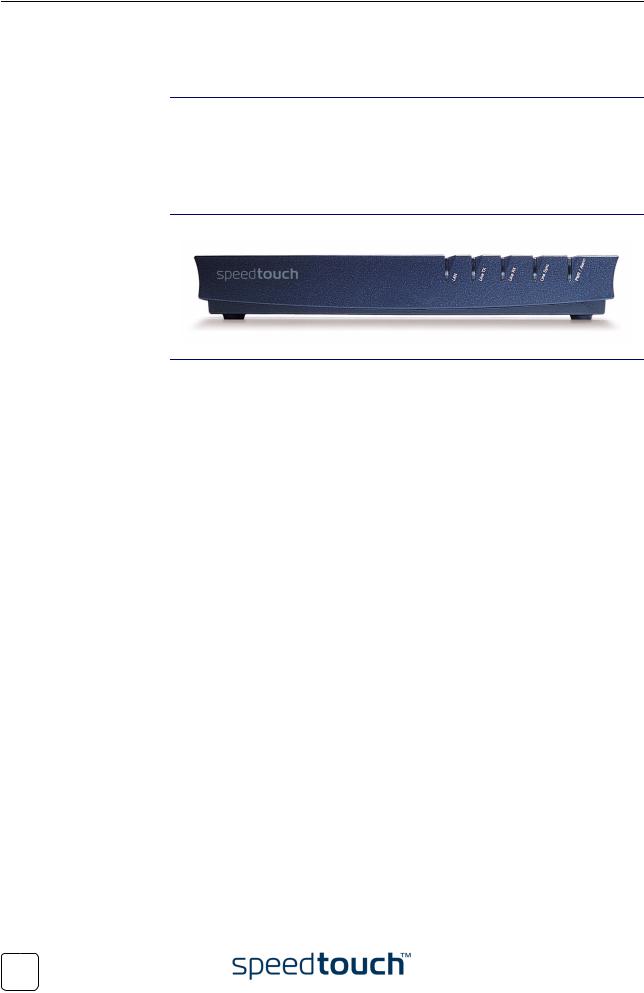
1 SpeedTouch™ Installation
1.1 Getting Acquainted with the SpeedTouch™
Introducing the Prior to proceeding, please make sure to read first the SpeedTouch™ Quick Installation SpeedTouch™ Guide. It provides important package content and safety information.
Check whether all items are present in your package.
In the event of damaged or missing items, please contact your local product dealer for further information.
Front panel layout The SpeedTouch™ is presented in a desktop housing:
Front panel LEDs The SpeedTouch™ is equipped with five LEDs on its front panel, indicating the state of the device during normal operation:
Indicator |
|
|
Description |
|
|
|
|
Name |
Color |
State |
|
|
|
|
|
LAN |
Green |
Flashing |
Wireless LAN activity |
|
|
|
|
|
|
Off |
No Wireless LAN activity |
|
|
|
|
Line TX |
Green |
Flashing |
ATM cell transmission on DSL line |
|
|
|
|
|
|
Off |
No transmission activity |
|
|
|
|
Line RX |
Green |
Flashing |
ATM cell reception from DSL line |
|
|
|
|
|
|
Off |
No reception activity |
|
|
|
|
Line Sync |
Green |
Off |
No DSL line |
|
|
|
|
|
|
Flashing |
Initialization of DSL line |
|
|
|
|
|
|
On |
DSL line synchronized |
|
|
|
|
PWR/Alarm |
Green |
On |
Power on, normal operation |
|
|
|
|
|
Amber |
Flashing |
WLAN client registration |
|
|
|
|
|
Red |
On |
Power on, startup pending |
|
|
|
|
6 |
E-DOC-CTC-20030814-0001 v1.0 |
|
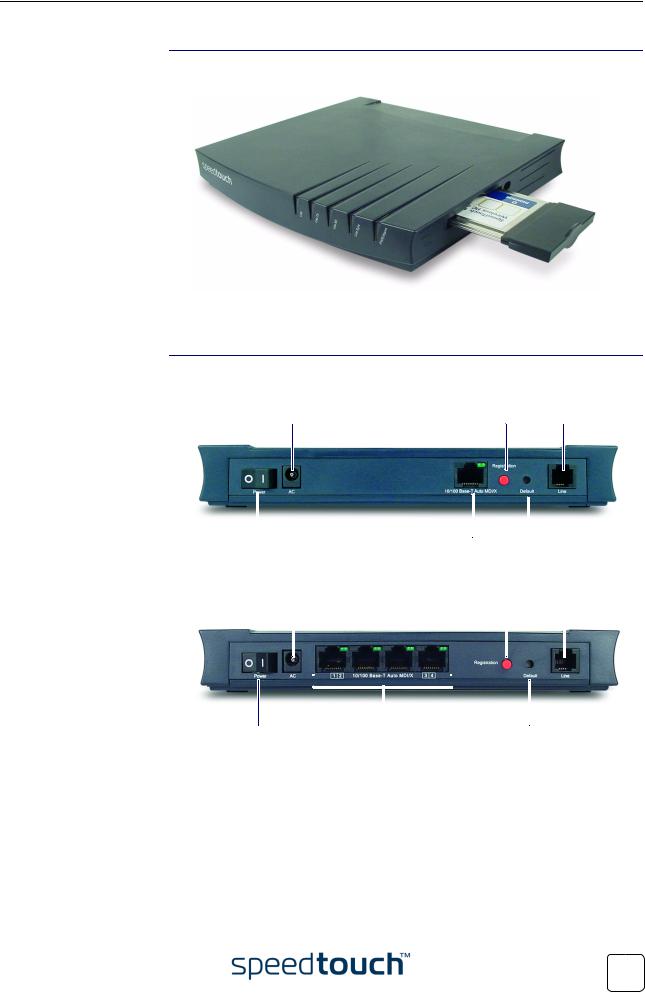
1 SpeedTouch™ Installation
SpeedTouch™545 The slot on the SpeedTouch™545 side panel allows you to upgrade your SpeedTouch™ side panel for wireless connectivity by installing a SpeedTouch™010 wireless upgrade card:
For more information on how to install the SpeedTouch™010 wireless upgrade card, see “7.1 Upgrading a SpeedTouch™545 for Wireless Networking” on page 74.
Back panel layout Depending on the variant you purchased, your SpeedTouch™ is equipped with:
•A single 10/100Base-T Half-/Full-duplex MDI/MDI-X Ethernet port:
Power Socket |
Registration button |
DSL port |
|
|
|
|
|
|
|
|
|
|
|
|
|
Default button |
|
Power Switch |
10/100Base-T Ethernet port |
|||
•A four port 10/100Base-T Half-/Full-duplex MDI/MDI-X Ethernet switch:
Power Socket |
Registration button |
DSL port |
|||||
|
|
|
|
|
|
|
|
|
|
|
|
|
|
|
|
|
|
|
|
|
|
|
|
|
|
|
|
|
|
|
|
|
|
|
|
|
|
|
|
|
|
|
|
|
|
|
|
Power Switch |
10/100Base-T Ethernet switch |
Default button |
E-DOC-CTC-20030814-0001 v1.0 |
7 |
|
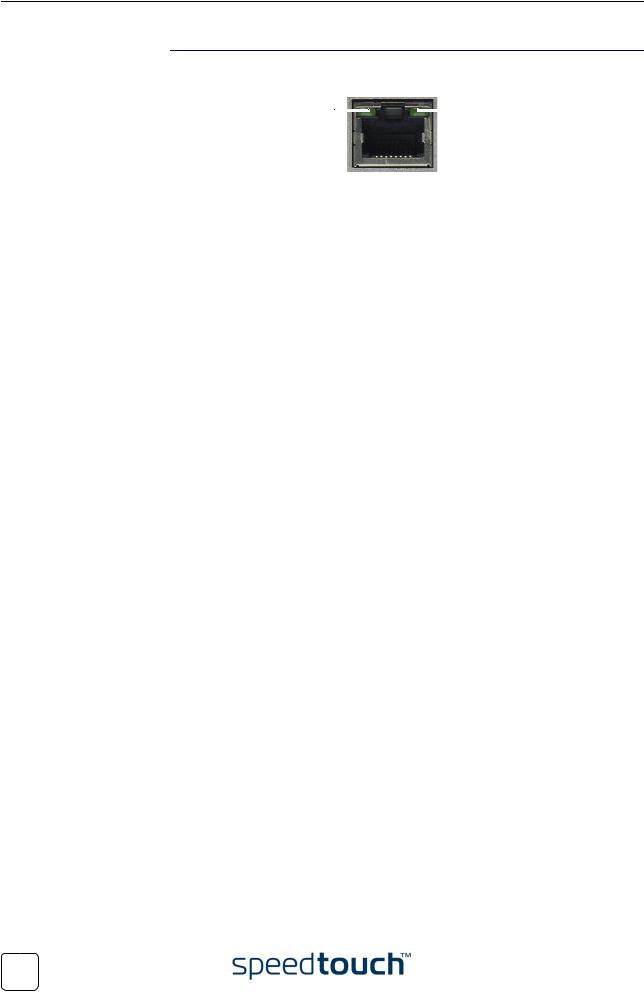
1 SpeedTouch™ Installation
Ethernet port LEDs Each Ethernet Port on the rear panel has one LED to indicate the link integrity/activity. A second LED may be provided to indicate the 10/100Base-T selection:
10/100 Base-T |
|
|
|
Link Integrity/Activity |
|
|
Indicator |
|
Description |
|
|
|
|
|
Name |
LED Status |
|
|
|
|
|
|
10/100Base-T |
Off |
10Base-T Ethernet connection. |
|
(Optional) |
|
|
|
On |
100Base-T Ethernet connection. |
||
|
|||
|
|
|
|
Integrity/Activity |
Off |
No connection on this port. |
|
|
|
|
|
|
On |
Ethernet link up. |
|
|
|
|
|
|
Flashing |
Data is flowing from/to this port. |
|
|
|
|
8 |
E-DOC-CTC-20030814-0001 v1.0 |
|

1 SpeedTouch™ Installation
1.2 Setting Up the SpeedTouch™
Wall mounting Part of the package is a wall mounting assembly which allows you to conveniently mount assembly the SpeedTouch™ on a wall. See “7.2 Using the Wall Mounting Assembly” on page 76
for more information.
SpeedTouch™ variants Two ADSL variants of the SpeedTouch™ exist:
•The ADSL/POTS variant connecting to an analog Plain Old Telephone Service (POTS) line
•The ADSL/ISDN variant connecting to a digital Integrated Services Digital Network (ISDN) line
You can identify your variant by checking the identification label located on the bottom of your SpeedTouch™.
Use only the SpeedTouch™ variant which is appropriate for the DSL service provided to your premises. Check with your Service Provider to determine whether your SpeedTouch™ is adapted to ADSL service requirements.
ADSL service The appropriate DSL service must be available at your premises:
•ADSL service must be enabled on your telephone line.
•As both telephone and ADSL service are simultaneously available from the same copper pair, you will need a central splitter or distributed filters for decoupling ADSL and telephone signals.
Always contact your Service Provider when installing splitters/filters!
Public telephone lines carry voltages that can cause electric shock. Only install splitter/ filters yourself if these are qualified for that purpose.
Connect the DSL line The DSL port on the SpeedTouch™ is marked “Line”.
Use the DSL cable provided to wire the SpeedTouch™ DSL port to your telephone wall outlet or distributed filter.
Connect the power Always check first whether the power supply adapter provided is suitable for the local supply power specifications. Contact your Service Provider in case of any doubt.
The power inlet on the SpeedTouch™ is marked “AC”.
Plug the adapter's coaxial jack into the SpeedTouch™'s power inlet and plug the power supply into a power socket outlet.
E-DOC-CTC-20030814-0001 v1.0 |
9 |
|

1 SpeedTouch™ Installation
Turn on the |
Once all previous steps are completed, you can turn the SpeedTouch™ on (I) with the |
|
SpeedTouch™ |
power switch. |
|
|
The SpeedTouch™ is ready for service as soon as the start-up procedures are |
|
|
completed, the Power On Self Test (POST) is passed and both Power/Alarm and Line |
|
|
Sync LEDs on the front panel are constantly lit green. |
|
|
Note |
You can follow the start-up procedure progress on the PWR/Alarm LED. |
|
|
See “ Front panel LEDs” on page 6 for more information. |
For troubleshooting startup failures, see “7.6 Troubleshooting” on page 91.
Local networking setup The SpeedTouch™ offers two local networking solutions:
•Wired Ethernet
The SpeedTouch™'s Ethernet port(s) on the back panel allow(s) you to connect the SpeedTouch™ to an existing 10 or 100Base-T Ethernet network or one (or more) computer(s) with installed Ethernet card.
•In case of a single Ethernet port SpeedTouch™, you will need an external hub or switch to connect multiple computers.
•In case of a SpeedTouch™ switch, you can create a local Ethernet network of up to four devices, without needing extra networking devices.
Note If an external hub or switch is used for wired Ethernet networking, please follow the installation instructions supplied with the hub for connections and Ethernet cabling.
•Wireless Ethernet
The SpeedTouch™ wireless access point allows multiple computers to connect to your local network over the SpeedTouch™ Wireless LAN environment.
To be able to connect the computers, make sure that:
•A Wireless Ethernet client adapter (WLAN client) is installed on each of the computers you want to connect via the Wireless Ethernet.
•In case you purchased a SpeedTouch™545, the wireless upgrade card is installed as described in “7.1 Upgrading a SpeedTouch™545 for Wireless Networking” on page 74.
For more information on how to proceed for associating WLAN clients, see “4 Wireless Connectivity” on page 41.
Internet connection To continue with preparing the SpeedTouch™ for Internet connectivity, see setup “1.3 SpeedTouch™ Configuration Setup” on page 11.
10 |
E-DOC-CTC-20030814-0001 v1.0 |
|

1 SpeedTouch™ Installation
1.3 SpeedTouch™ Configuration Setup
Internet connectivity Some configuration may be required to prepare the SpeedTouch™ for Internet connectivity.
Before setting up the SpeedTouch™ for Internet connectivity, make sure that the SpeedTouch™ is prepared as described in “1.2 Setting Up the SpeedTouch™” on page 9.
You can configure the SpeedTouch™:
•Over the traditional wired Ethernet network
•Over the SpeedTouch™ wireless Ethernet network
If you want to configure the SpeedTouch™ over the wireless interface, make sure that your computer’s WLAN client is correctly associated with the SpeedTouch™ wireless network according to “4.1 First-time Wireless Client Association” on page 43 before proceeding.
What you need from You might need a user account with an Internet Service Provider (ISP) for Internet your ISP access. For this user account, your ISP will provide you with:
•A user name (logon ID).
•A password.
Other information may be required, depending on the ISP’s specific requirements and
Service profile selection.
SpeedTouch™ The method for configuring the SpeedTouch™ via the Setup configuration files depends configuration options on the Operating System (OS) of your computer system.
If your computer system runs:
•A Microsoft Windows Operating System:
The SpeedTouch™ Setup wizard, included on the SpeedTouch™ Setup CD-ROM, will automatically guide you through the configuration of both the SpeedTouch™ and your PC for setting up the appropriate configuration.
Proceed with “1.3.1 Microsoft Windows SpeedTouch™ Configuration Setup” on page 12.
In addition it is recommended to install Dr SpeedTouch™. See “3 Dr SpeedTouch™” on page 37 for more information.
•Another Operating System (e.g. Apple Mac OS, UNIX, Linux, etc.):
The SpeedTouch™ Embedded Easy Setup wizard, accessible from the SpeedTouch™ web pages, will automatically guide you through the configuration of the SpeedTouch™.
Proceed with “1.3.2 Operating System Independent SpeedTouch™ Configuration Setup” on page 19.
E-DOC-CTC-20030814-0001 v1.0 |
11 |
|

1SpeedTouch™ Installation
1.3.1Microsoft Windows SpeedTouch™ Configuration Setup
Supported MS |
One of the following MS Windows OSs must be installed on your PC(s): |
|
Windows OSs |
• |
MS Windows 98 |
|
• |
MS Windows 98SE |
|
• |
MS Windows ME |
|
• MS Windows NT4.0 SP6 |
|
|
• |
MS Windows 2000 |
|
• |
MS Windows XP |
|
You may need the MS Windows installation CD-ROM during installation. |
|
The SpeedTouch™ |
|
|
The SpeedTouch™ Setup wizard procedure consists of three parts: |
||
Setup wizard |
• |
Detection of the SpeedTouch™ |
|
• |
Configuration of the SpeedTouch™ (and PC) |
|
• |
Additional configuration (if needed) |
12 |
E-DOC-CTC-20030814-0001 v1.0 |
|
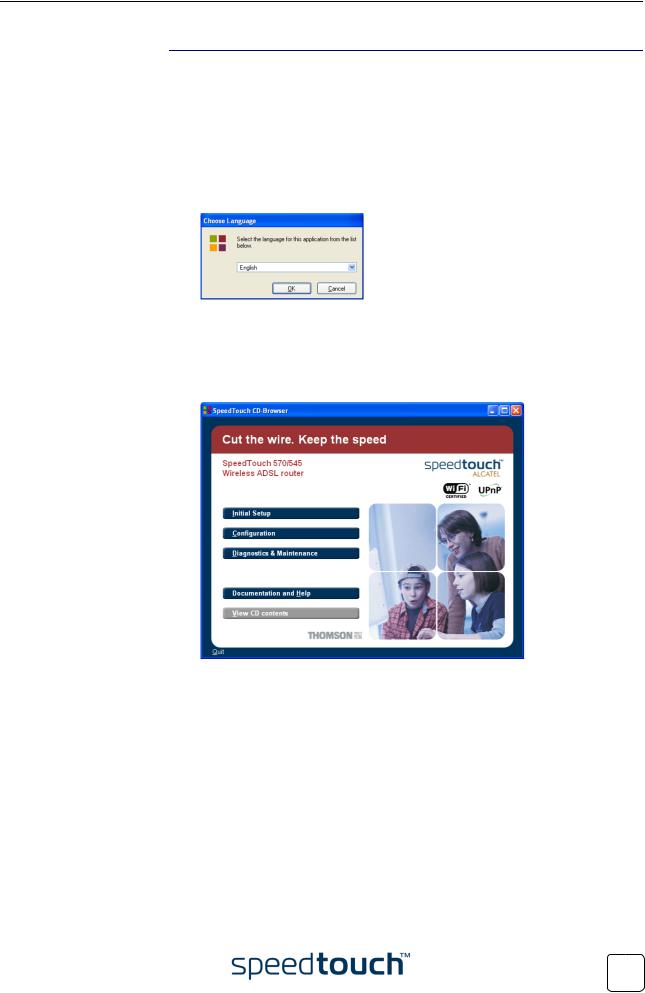
1 SpeedTouch™ Installation
Detection of the
SpeedTouch™
Proceed as follows:
1Insert the SpeedTouch™ Setup CD-ROM in your PC's CD-ROM drive. The SpeedTouch™ CD Browser will start automatically.
Note If the SpeedTouch™ CD Browser window does not appear automatically, open a Run window via Start > Run from the Start menu and enter the following path: D:\Menu.exe, where D stands for the drive letter of your CD-ROM drive.
2The Choose Language window prompts you to select a language:
Select the language of your choice and click OK.
Note The selected language will also be used as default language in the SpeedTouch™ web pages. See “ Language” on page 66 for more information on how to change the web page language.
3The SpeedTouch™ CD Browser menu appears:
Click Initial Setup.
E-DOC-CTC-20030814-0001 v1.0 |
13 |
|
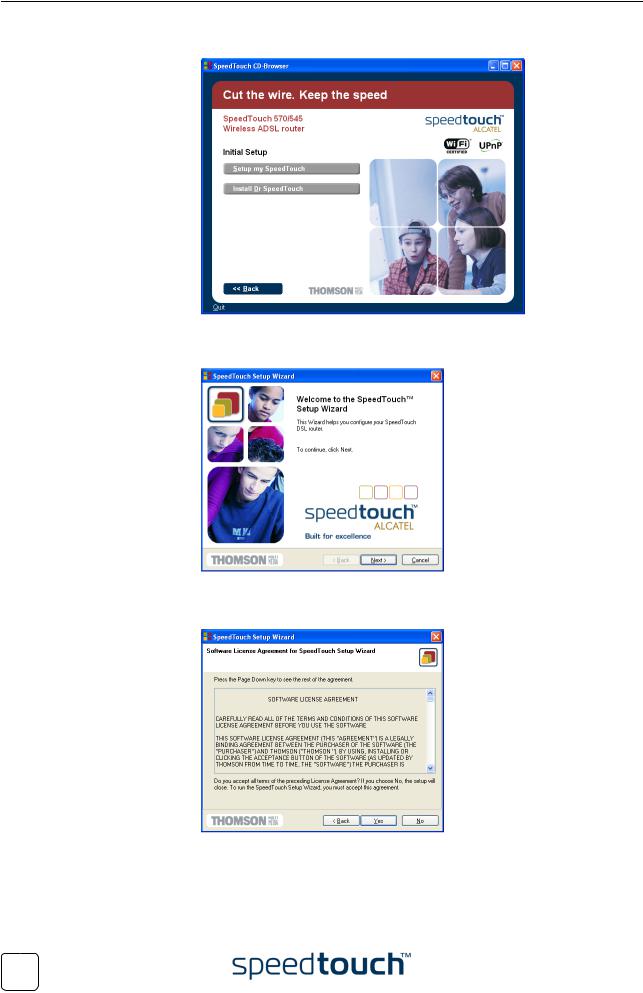
1 SpeedTouch™ Installation
4 The Initial Setup window appears:
Click Setup my SpeedTouch™ to start the SpeedTouch™ Setup wizard. 5 The Welcome to the SpeedTouch™ Setup Wizard window appears:
Click Next.
6 The Software License Agreement window appears:
You must accept before continuing. Click Yes to accept.
Note If you accepted this License Agreement in a previous configuration setup, this window will not be shown anymore.
14 |
E-DOC-CTC-20030814-0001 v1.0 |
|
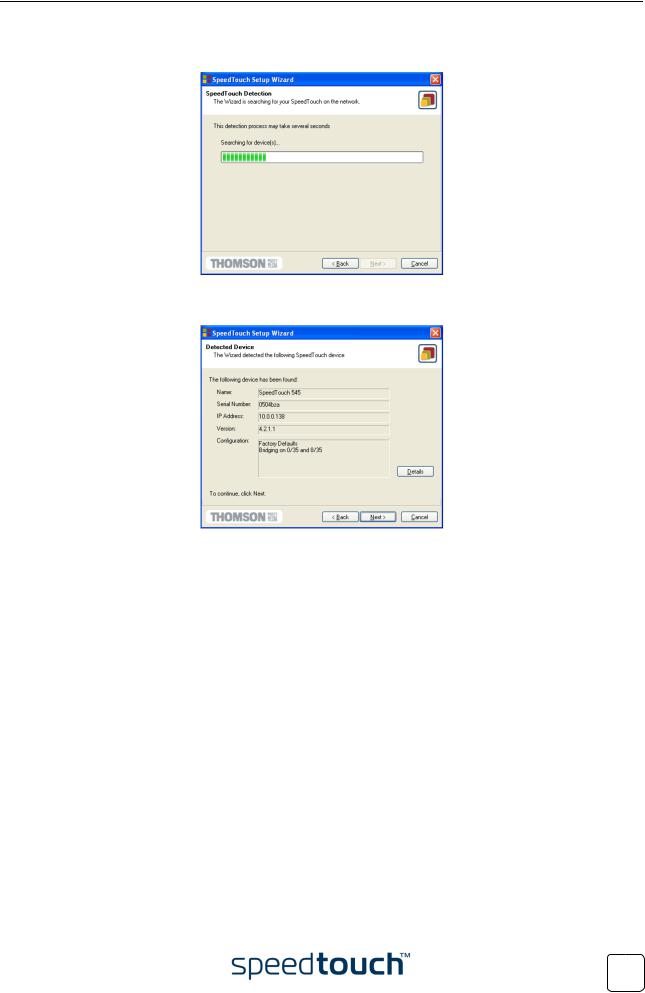
1 SpeedTouch™ Installation
7The Setup wizard will search for the SpeedTouch™ on the network. The following window shows the detection progress:
8The Setup wizard should find your SpeedTouch™ device on the local network. This is indicated by the following window:
If more than one device is found, a list of available devices will be provided. If this is the case, select your SpeedTouch™ device (SpeedTouch™545 or SpeedTouch™570) and click Next.
Note If the Setup wizard does not find any SpeedTouch™ on the network an error window appears. In this case check that:
•The SpeedTouch™ is turned on and fully initialized.
•Your PC is correctly connected to the SpeedTouch™ or the WLAN client is correctly associated with the SpeedTouch™ WLAN as described in “4.1 First-time Wireless Client Association” on page 43.
•Your PC has a valid IP address (i.e. any IP address but 0.0.0.0).
•No dedicated firewall device or router is placed between your PC and the SpeedTouch™.
•No personal firewall software is running on your PC.
•TCP/IP is correctly installed on your PC.
To repeat the search for your SpeedTouch™, click Back and proceed with step 7 of this procedure.
9 Click Next to start the configuration procedure as described below.
E-DOC-CTC-20030814-0001 v1.0 |
15 |
|

1 SpeedTouch™ Installation
Configuration of the |
Proceed as follows: |
||
SpeedTouch™ (and PC) |
1 |
As soon as the SpeedTouch™ Setup wizard has detected your SpeedTouch™ |
|
|
|||
|
|
device, you can proceed with the configuration procedure. |
|
|
|
Note |
If the SpeedTouch™ has been configured before: |
• It may be protected by a system password. You must provide this password before you can view the device details or continue with the configuration.
• You will be asked to choose between reconfiguring your SpeedTouch™ or changing your Local Area Network configuration. Select the Reconfigure the SpeedTouch™ option and click Next.
2The following window invites you to select the appropriate service for your Internet connectivity:
Select Region, Provider and Service as specified by your Service Provider and click Next to continue.
Note If the Service Provider has included a separate disk with a dedicated Service profile, click Have Disk to navigate to the location of the appropriate Service template file.
3Subsequent screens will guide you through the configuration setup of both the SpeedTouch™ and your PC. Follow the instructions and enter the required information whenever needed. The requested information will depend on the selected Service profile and should be provided by your Service Provider.
Click Next whenever requested.
16 |
E-DOC-CTC-20030814-0001 v1.0 |
|
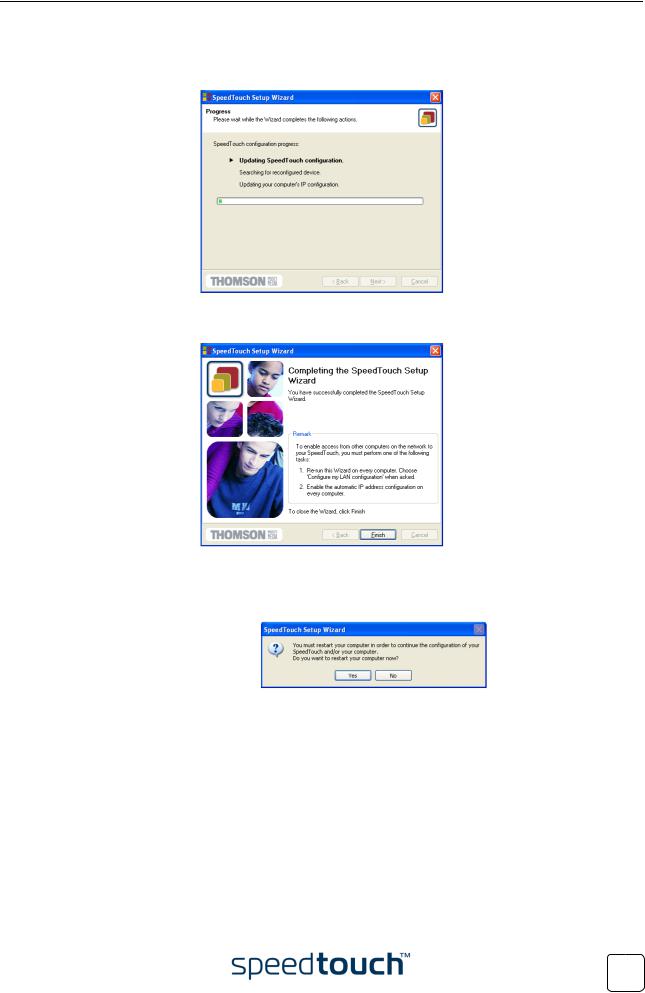
1 SpeedTouch™ Installation
4The SpeedTouch™ Setup wizard will update the SpeedTouch™ configuration and your PC’s configuration according to the Service profile. You can follow the configuration progress in following window:
5As soon as the SpeedTouch™ Setup wizard completed the update of the SpeedTouch™ configuration and reconfigured your PC, following window will appear:
Click Finish to close the wizard.
Note In some cases, the SpeedTouch™ Setup wizard may ask you to restart your computer:
E-DOC-CTC-20030814-0001 v1.0 |
17 |
|

1 SpeedTouch™ Installation
Additional configuration Some additional configuration may be needed:
•Wireless Settings
When running the SpeedTouch™ Setup wizard, the SpeedTouch™ wireless Access Point settings will be set to their default values. You might need to re-asso- ciate your WLAN clients, using the factory defaults WLAN settings as specified in “4.1 First-time Wireless Client Association” on page 43.
For additional security of your wireless network it is recommend to “personalize” your SpeedTouch™ wireless Access Point settings. See “4 Wireless Connectivity” on page 41 for more information.
•MS Windows IP configuration
Most Service profiles will enable the SpeedTouch™ DHCP server. Since by default a PC’s Ethernet interface is configured for obtaining its IP configuration dynamically (DHCP client), in most cases, no additional configuration is required.
To make sure that all PCs are configured as expected (DHCP or fixed IP addresses):
1 Re-run the SpeedTouch™ Setup wizard on every PC.
2 Select Change the LAN configuration.
3 Follow the instructions.
Note For fixed IP configurations, or other advanced settings, please follow the instructions provided by your Service Provider or network administrator.
•It is recommended to install Dr SpeedTouch™ to allow monitoring and troubleshooting of your SpeedTouch™. Proceed with “3 Dr SpeedTouch™” on page 37.
18 |
E-DOC-CTC-20030814-0001 v1.0 |
|

1 SpeedTouch™ Installation
1.3.2Operating System Independent SpeedTouch™ Configuration Setup
Supported Systems As the SpeedTouch™ is OS-independent, this configuration setup can be used by any computer system.
Prerequisites Make sure that:
•The SpeedTouch™ device is correctly set up and turned on as described in “1.2 Setting Up the SpeedTouch™” on page 9.
•The SpeedTouch™ device is in its default configuration state.
See “7.4 SpeedTouch™ Default Configuration” on page 88 for resetting your device.
•If you want to configure the SpeedTouch™ over the wireless network, the computer’s WLAN client is installed and correctly associated with the SpeedTouch™ wireless network according to “4.1 First-time Wireless Client Association” on page 43.
•The computer’s Operating System supports TCP/IP and it’s Ethernet interface is configured for obtaining its IP configuration dynamically.
Note In case of problems with DHCP you can also configure the computer’s Ethernet interface with a static Net10 private IP address, e.g. 10.0.0.1, 10.0.0.2, but make sure NOT to use the 10.0.0.138 IP address as this is the default IP address of the SpeedTouch™.
•Your web browser is able to run Java scripts.
SpeedTouch™ |
SpeedTouch™ Easy Setup consists of two parts: |
|
Easy Setup |
• |
Configuration of the SpeedTouch™ |
|
• |
Additional configuration (if needed) |
E-DOC-CTC-20030814-0001 v1.0 |
19 |
|
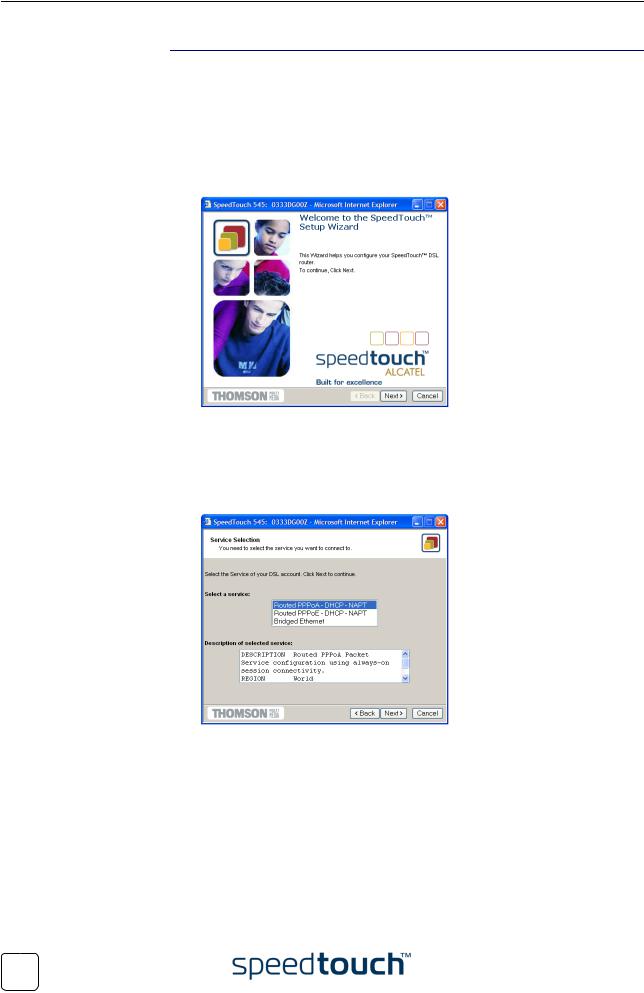
1 SpeedTouch™ Installation
Configuration of the
SpeedTouch™
Proceed as follows:
1Open a web browser and browse to the SpeedTouch™ web pages at http://10.0.0.138. See “5 SpeedTouch™ Web Interface” on page 47 for more information.
Note If you can not access the SpeedTouch™ web pages, it is probably not in its default state. It is recommended to reset the device.
2 The embedded Easy Setup wizard will appear automatically:
Click Next.
Note If Easy Setup doesn’t start automatically go to
Advanced > Easy Setup.
3The following window invites you to select the appropriate Service for your internet connectivity:
In the Service list, select the Service as specified by your Service Provider and click Next to continue.
Note If only one Service is available, this window will not be shown.
4Subsequent screens will guide you through the configuration setup of the SpeedTouch™. Follow the instructions and enter the required information whenever needed. The requested information will depend on the selected Service profile and should be provided by your Service Provider.
Click Next whenever requested.
20 |
E-DOC-CTC-20030814-0001 v1.0 |
|
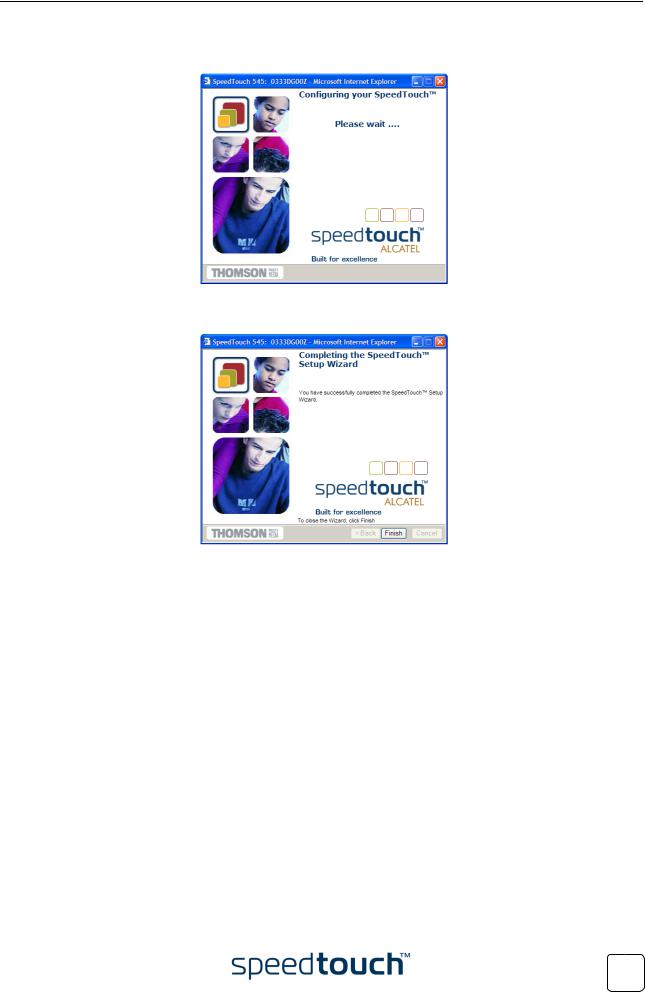
1 SpeedTouch™ Installation
5Easy Setup will update the SpeedTouch™ configuration according to the Service profile. You can follow the configuration progress in following window:
6As soon as Easy Setup completed the update of the SpeedTouch™ configuration, following window will appear:
Click Finish to close the wizard.
Note Due to the reconfiguration the SpeedTouch™’s IP configuration or wireless Access Point settings may have been changed. If this is the case, the last window of Easy Setup will not be shown. If so, refer to the Service Provider’s instructions for more information.
E-DOC-CTC-20030814-0001 v1.0 |
21 |
|

1 SpeedTouch™ Installation
Additional configuration Some additional configuration may be needed:
•Wireless Settings
When running the SpeedTouch™ Setup wizard, the SpeedTouch™ wireless Access Point settings will be set to their default values. You might need to re-asso- ciate your WLAN clients, using the factory defaults WLAN settings as specified in “4.1 First-time Wireless Client Association” on page 43.
For additional security of your wireless network it is recommend to “personalize” your SpeedTouch™ wireless Access Point settings. See “4 Wireless Connectivity” on page 41 for more information.
•Computer IP configuration
Most Service profiles will enable the SpeedTouch™ DHCP server. Therefore, make sure that the computer’s Ethernet interface is configured for obtaining its IP configuration dynamically (DHCP client).
Note For fixed IP configurations, or other advanced settings, please follow the instructions provided by your Service Provider or network administrator.
22 |
E-DOC-CTC-20030814-0001 v1.0 |
|

2 SpeedTouch™ Internet Connectivity
2 SpeedTouch™ Internet Connectivity
Introduction This chapter provides information on how to configure your SpeedTouch™ according to your preferences and how to access the Internet.
Access methods As soon as the SpeedTouch™ and your computers have been configured as outlined in “1.3 SpeedTouch™ Configuration Setup” on page 11, you are able to connect to the Internet.
Depending on the configuration of the SpeedTouch™ you may have:
•Direct access
As soon as the initial configuration has been performed, continuous and immediate access is available via the DSL line.
•Dial-in access
Access must be explicitly established, e.g. by “dialing” into a Broadband Remote Access Server (BRAS).
The applied connection protocol model depends on the Service profile you selected to configure the SpeedTouch™ and should correspond with the Service Provider's requirements.
Dial-in access Depending on the SpeedTouch™ configuration, dial-in access is provided via:
•The SpeedTouch™’s Routed PPPoA or Routed PPPoE packet services with embedded PPP client.
See “2.1 Internet Connections via SpeedTouch™’s Embedded PPP Dial-in Client.” on page 24 for more information.
•A broadband dial-in client on your computer.
See “2.2 Connect to the Internet via a Host PPPoE Dial-in Client” on page 29 for more information.
Your Internet Regardless of whether a direct access or a dial-in access method is used to make your connection connection, once the connection is established, opening your web browser is enough to
access the World Wide Web (WWW) or Internet.
Note In case of direct access, the remote organization might ask for a user name and password on an Internet welcome page.
E-DOC-CTC-20030814-0001 v1.0 |
23 |
|

2SpeedTouch™ Internet Connectivity
2.1Internet Connections via SpeedTouch™’s Embedded PPP Dial-in Client.
Introduction The SpeedTouch™ supports both most popular connection methods: Routed PPP over ATM (PPPoA) and PPP over Ethernet (PPPoE).
The connection method depends on the Service profile you selected to configure the SpeedTouch™ and should correspond with the Service Provider’s requirements.
To use:
•the embedded Routed PPPoA dial-in client, the SpeedTouch™ needs to be configured for the Routed PPPoA Service.
•the embedded Routed PPPoE dial-in client, the SpeedTouch™ needs to be configured for the Routed PPPoE Service.
Both Services are available via the SpeedTouch™ Setup wizard or via the embedded
Easy Setup.
Using SpeedTouch™ SpeedTouch™’s embedded PPP dial-in client allows you to establish an Internet connec- embedded PPP dial-in tion for all (or a selection of) computers residing on your local network, using only one
client computer of the network to control the client. If this computer runs:
•MS Windows XP,
you can use MS Windows XP’s Internet Gateway Device Control Client.
See “2.1.1 Using the MS Windows XP Internet Gateway Device Control Client” on page 25 to proceed.
•another Operating System,
you can use the SpeedTouch™ web pages.
See “2.1.2 Using the SpeedTouch™ Web Pages” on page 27 to proceed.
24 |
E-DOC-CTC-20030814-0001 v1.0 |
|
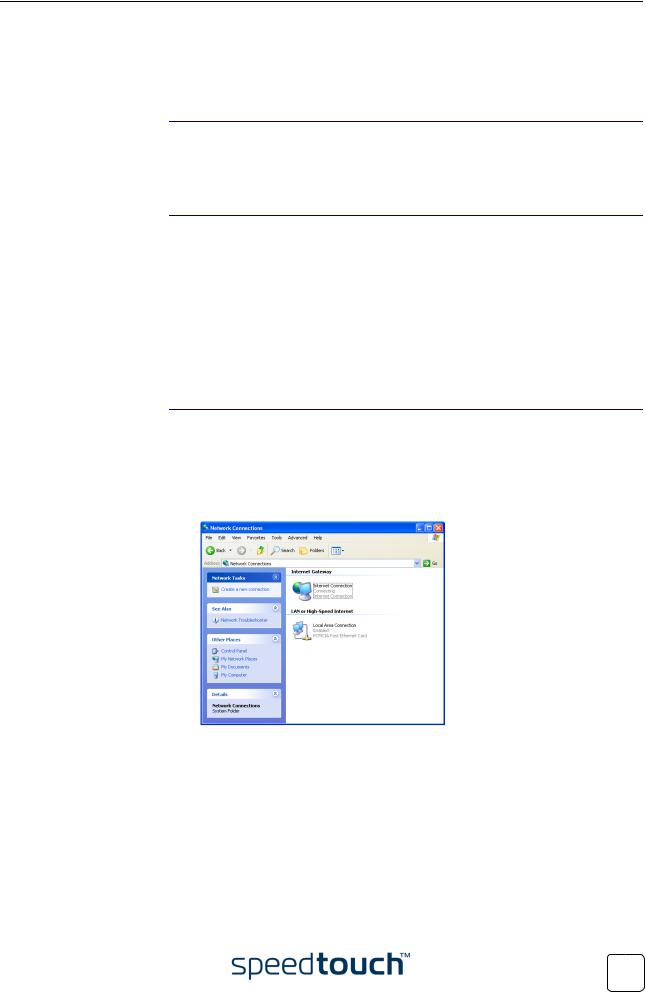
2 SpeedTouch™ Internet Connectivity
2.1.1Using the MS Windows XP Internet Gateway Device Control Client
Introduction MS Windows XP users can easily establish PPP sessions, without the need of first browsing to the SpeedTouch™ web pages, due to MS Windows XP’s Internet Gateway Device Discovery and Control Client that allows you to control the SpeedTouch™ directly from you PC.
Preconditions Following conditions must be met:
•UPnP™ (subcomponent of Windows XP’s Networking Services) must be added to your Windows XP system (see “7.5 UPnP™ on Windows XP Systems” on page 89)
•Internet Gateway Device Discovery and Control Client (subcomponent of Windows XP’s Networking Services) must be enabled on your Windows XP system (see “7.5 UPnP™ on Windows XP Systems” on page 89)
•Make sure UPnP™ is fully enabled on the SpeedTouch™ (see “ NAPT” on page 59)
Starting an Internet
session
Proceed as follows:
1Click (Settings >) Control Panel on the Start menu.
2The Control Panel window appears. Go to (Network and Internet Connections >)
Network Connections.
3The Network Connections window appears:
Next to your Network connection(s), you can find an Internet Gateway icon, representing the SpeedTouch™ Internet Gateway Device Internet connection ability.
4 Double-click the Internet Connection icon.
As a result SpeedTouch™’s embedded PPP dial-in client establishes the Internet connection. The Internet Gateway icon displays connected and your PC is online.
You can open a web browser and surf the Internet.
E-DOC-CTC-20030814-0001 v1.0 |
25 |
|
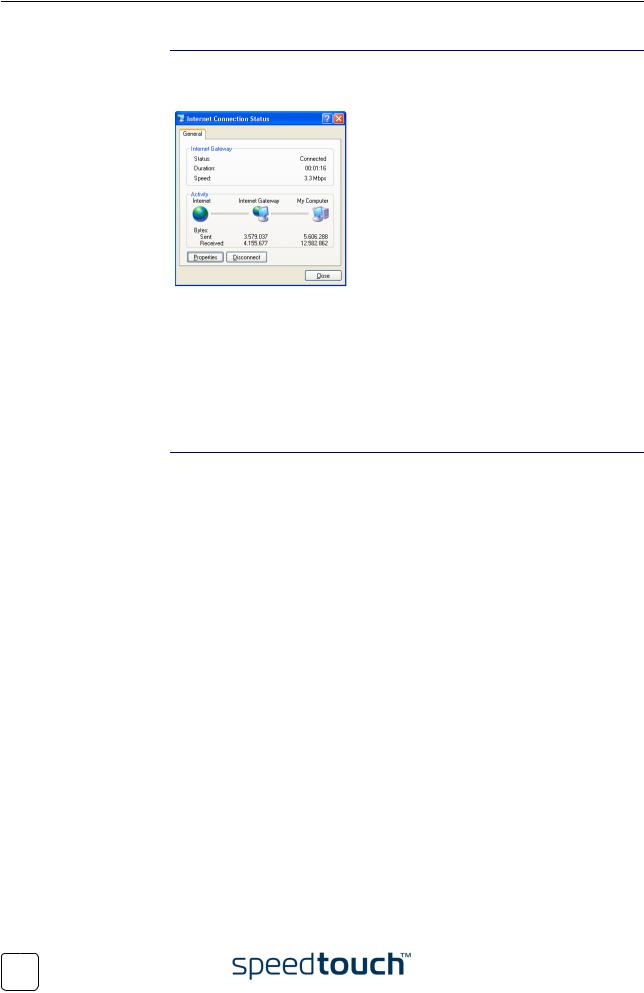
2 SpeedTouch™ Internet Connectivity
The connected Internet As long as the SpeedTouch™’s embedded PPP dial-in client is connected, you are able to Gateway overview the connection status and some counters by double-clicking the Internet
Connection icon in your PC’s Network Connections window:
More detailed monitoring is provided via:
•Dr SpeedTouch™
See “3 Dr SpeedTouch™” on page 37.
•The SpeedTouch™ System Information page See “ System Information” on page 50.
•The SpeedTouch™ Diagnostics page See “ Diagnostics” on page 56.
Terminating an Internet
session
Proceed as follows:
1Click (Settings >) Control Panel on the Start menu.
2The Control Panel window appears. Go to (Network and Internet Connections >)
Network Connections.
3The Network Connections window appears.
4Right-click the Internet Connection icon and select Disconnect to close the session.
Note You can also double-click the icon. As a result the Internet Connection Status window appears from which a Disconnect button is available to close the session.
As a result SpeedTouch™’s embedded PPP dial-in client will close the Internet connection. The Internet Gateway icon displays disconnected and your PC is offline.
26 |
E-DOC-CTC-20030814-0001 v1.0 |
|
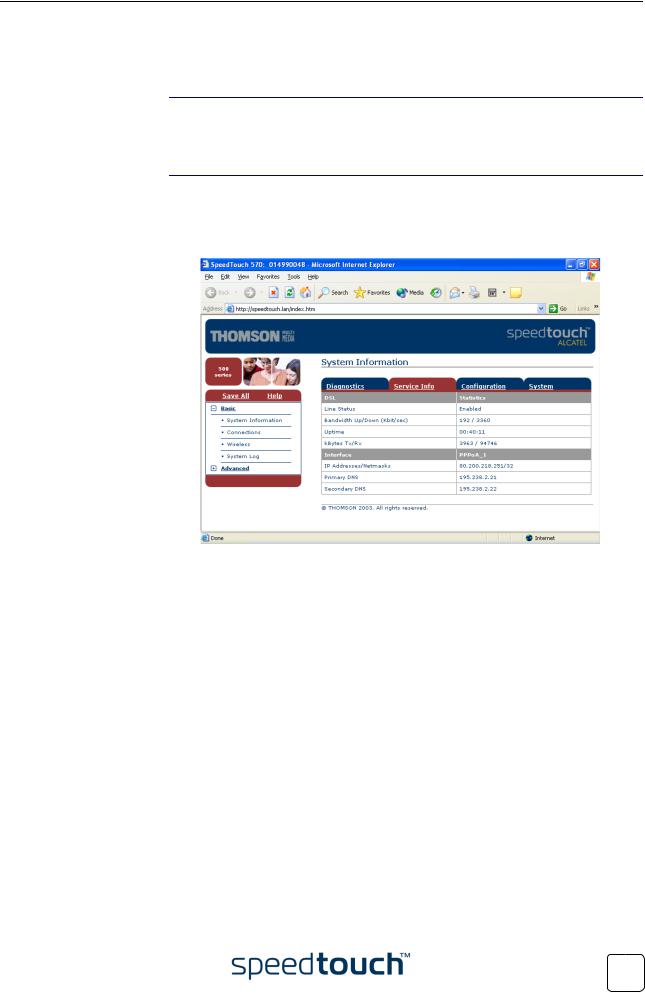
2 SpeedTouch™ Internet Connectivity
2.1.2 Using the SpeedTouch™ Web Pages
Introduction
Starting an Internet
session
As the SpeedTouch™ web pages are controllable from any Operating System with installed web browser, the method to establish PPP sessions described below can be used by any computer system.
Proceed as follows:
1Open a web browser on your computer and browse to the SpeedTouch™ web pages (see “ Access to the SpeedTouch™ web interface” on page 47 for more information):
By default the SpeedTouch™ shows you the System Information page.
2In the Basic menu, click Connections to open the Connections page that allows you to establish dial in-in connections.
3Click  next to the connection entry you want to establish a connection with. As a result the entry will be highlighted.
next to the connection entry you want to establish a connection with. As a result the entry will be highlighted.
4Enter your user name and password in the appropriate fields. If you want the SpeedTouch™ to remember your credentials, select the Save this password.
5Click Connect.
As a result SpeedTouch™’s embedded PPP dial-in client establishes the Internet connection.
During session-establishment the State column will display Trying. As soon as the PPP session is started successfully the field displays up and your PC is online.
You can open a web browser and surf the Internet.
E-DOC-CTC-20030814-0001 v1.0 |
27 |
|

2 SpeedTouch™ Internet Connectivity
During the Internet You are able to overview and monitor your Internet connectivity as long as the session session is running via:
•Dr SpeedTouch™
See “3 Dr SpeedTouch™” on page 37.
•The SpeedTouch™ System Information page See “ System Information” on page 50.
•The SpeedTouch™ Diagnostics page See “ Diagnostics” on page 56.
Terminating an Internet
session
To close an active Routed PPP connection:
1Make sure you have access to the SpeedTouch™ web pages.
2On the Connections page, click  next to the connection entry you want to close the connection for.
next to the connection entry you want to close the connection for.
3Click Disconnect.
As a result SpeedTouch™’s embedded PPP dial-in client will close the Internet connection. The entry's session state will change to Down and your PC is offline.
28 |
E-DOC-CTC-20030814-0001 v1.0 |
|
